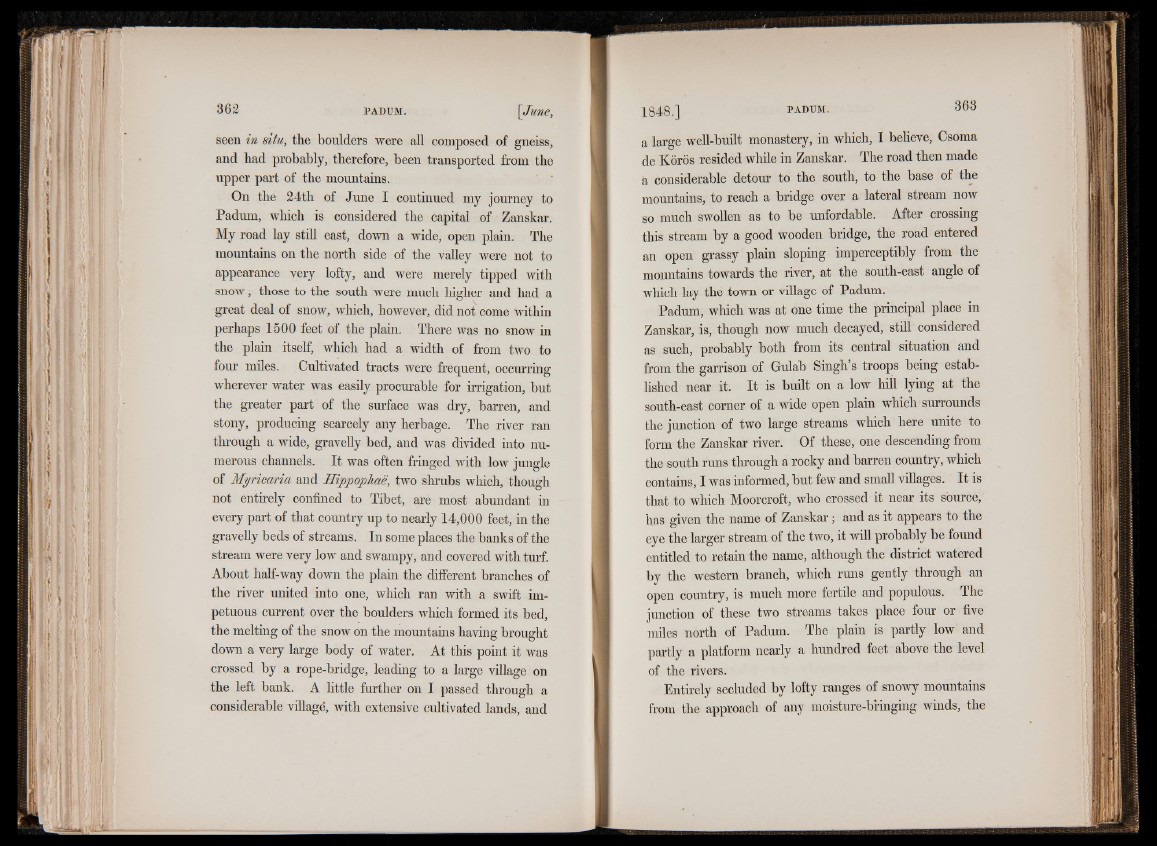
seen in situ, the boulders were all composed of gneiss,
and had probably, therefore, been transported from the
upper part of the mountains.
On the 24th of June I continued my journey to
Padum, which is considered the capital of Zanskar.
My road lay still east, down a wide, open plain. The
mountains on the north side of the valley were not to
appearance very lofty, and were merely tipped with
snow; those to the south were much higher and had a
great deal of snow, which, however, did not come within
perhaps 1500 feet of the plain. There was no snow in
the plain itself, which had a width of from two to
four miles. Cultivated tracts were frequent, occurring
wherever water was easily procurable for irrigation, but
the greater part of the surface was dry, barren, and
stony, producing scarcely any herbage. The river ran
through a wide, gravelly bed, and was divided into numerous
channels. It was often fringed with low jungle
of Myricaria and Hippophae, two shrubs which, though
not entirely confined to Tibet, are most abundant in
every part of that country up to nearly 14,000 feet, in the
gravelly beds of streams. In some places the banks of the
stream were very low and swampy, and covered with turf.
About half-way down the plain the different branches of
the river united into one, which ran with a swift impetuous
current over the boulders which formed its bed,
the melting of the snow on the mountains having brought
down a very large body of water. At this point it was
crossed by a rope-bridge, leading to a large village on
the left bank. A little further on I passed through a
considerable village, with extensive cultivated lands, and
a large well-built monastery, in which, I believe, Csoma
de Koros resided while in Zanskar. The road then made
a considerable detour to the south, to the base of the
mountains, to reach a bridge over a lateral stream now
so much swollen as to be unfordable. After crossing
this stream by a good wooden bridge, the road entered
an open grassy plain sloping imperceptibly from the
mountains towards the river, at the south-east angle of
which lay the town or village of Padum.
Padum, which was at one time the principal place in
Zanskar, is, though now much decayed, still considered
as such, probably both from its central situation and
from the garrison of Gulab Singh s troops being established
near it. It is built on a low hill lying at the
south-east corner of a wide open plain which surrounds
the junction of two large streams which here unite to
form the Zanskar river. Of these, one descending from
the south runs through a rocky and barren country, which
contains, I was informed, but few and small villages. It is
that to which Moorcroft, who crossed it near its source,
has given the name of Zanskar; and as it appears to the
eye the larger stream of the two, it will probably be found
entitled to retain the name, although the district watered
by the western branch, which runs gently through an
open country, is much more fertile and populous. The
junction of these two streams takes place four or five
miles north of Padum. The plain is partly low and
partly a platform nearly a hundred feet above the level
of the rivers.
Entirely secluded by lofty ranges of snowy mountains
from the approach of any moisture-bringing winds, the